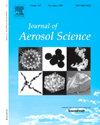“SARS-CoV-2 airborne detection within different departments of a COVID-19 hospital building and evaluation of air cleaners in air viral load reduction”
IF 3.9
3区 环境科学与生态学
Q2 ENGINEERING, CHEMICAL
引用次数: 0
Abstract
The pandemic of COVID-19 has brought in light the necessity for the development of novel detection methods for airborne transmitted pathogens, and the importance of effective clean air measures in hospital departments. In this study, airborne SARS-CoV-2 and particle matter (PM1, PM2.5) detection was performed in different areas of the COVID-19 building at the Ippokrateio University Hospital in Thessaloniki, Greece. More specifically, Sioutas cascade impactors were placed in the ICU (Intensive Care Unit) and HDU (High-Dependency Unit) on the first floor, and at the corridor and rooms at the COVID-19 clinic on the second floor. Furthermore, TECORA air pumps were placed at the building entrance to measure for PM1 and PM2.5. Afterwards, in a COVID room with confirmed air viral load an air cleaner was placed to examine the effect on viral load reduction. Results showed that no viral copies were detected in the air of ICU and HDU departments, in which negative pressure air filtration with HEPA filters is applied. On the contrary, viral load was effectively detected in rooms and corridors of the COVID floor and ranged from 25,9 to 1123,7 copies/m3. PM1 filters showed 77.8 % viral positivity, and PM2.5 filters were 38.5 % virus positive. Moreover, air viral load in the COVID room with an air cleaner showed a reduction of up to 98.1 %. In conclusion, SARS-CoV-2 was effectively detected in the air of different areas in the COVID building after continuous sampling ranging between 24 h and 7 days, and it was shown how important and effective air cleaners are as first-line measures against pathogen airborne transmission in hospital environments.

“某新型冠状病毒肺炎医院不同科室空气中SARS-CoV-2检测及空气净化器降低空气病毒载量效果评价”
2019冠状病毒病大流行凸显了开发新型空气传播病原体检测方法的必要性,以及在医院科室采取有效清洁空气措施的重要性。在这项研究中,在希腊塞萨洛尼基伊波克拉提奥大学医院的COVID-19大楼的不同区域进行了空气中SARS-CoV-2和颗粒物(PM1, PM2.5)检测。更具体地说,Sioutas的级联影响器被放置在一楼的ICU(重症监护病房)和HDU(高依赖病房),以及二楼COVID-19诊所的走廊和房间。此外,在建筑入口处放置了TECORA气泵来测量PM1和PM2.5。之后,在确认空气病毒载量的COVID房间中放置空气净化器以检查病毒载量降低的效果。结果ICU和HDU科室空气中均未检出病毒拷贝,采用HEPA过滤器负压空气过滤。相反,在COVID楼层的房间和走廊中有效检测到病毒载量,范围为25,9至1123,7拷贝/m3。PM1过滤器的病毒阳性率为77.8%,PM2.5过滤器的病毒阳性率为38.5%。此外,在配备空气净化器的COVID房间中,空气病毒载量下降了98.1%。综上所述,通过24 h至7天的连续采样,在新冠大楼不同区域的空气中有效检测到SARS-CoV-2,显示了空气净化器作为医院环境中预防病原体空气传播的一线措施的重要性和有效性。
本文章由计算机程序翻译,如有差异,请以英文原文为准。
求助全文
约1分钟内获得全文
求助全文
来源期刊

Journal of Aerosol Science
环境科学-工程:化工
CiteScore
8.80
自引率
8.90%
发文量
127
审稿时长
35 days
期刊介绍:
Founded in 1970, the Journal of Aerosol Science considers itself the prime vehicle for the publication of original work as well as reviews related to fundamental and applied aerosol research, as well as aerosol instrumentation. Its content is directed at scientists working in engineering disciplines, as well as physics, chemistry, and environmental sciences.
The editors welcome submissions of papers describing recent experimental, numerical, and theoretical research related to the following topics:
1. Fundamental Aerosol Science.
2. Applied Aerosol Science.
3. Instrumentation & Measurement Methods.
 求助内容:
求助内容: 应助结果提醒方式:
应助结果提醒方式:


